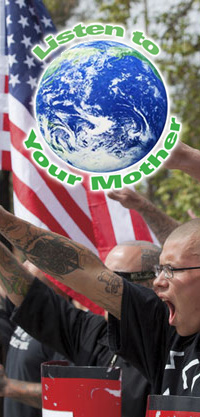| Index - September/October 2017 |
|
Sabra Field and Julia Alvarez: Two Creative Vermonters Collaborate
by Cynthia Close
|
Vermont has been a fertile place of inspiration for many artists and writers, but few have embraced it as significantly as printmaker Sabra Field. The green mountains, fecund valleys, dirt roads, deep lakes, and meandering streams have all been subject matter and were clearly on display during the artist's recent retrospective of her last 60 years of image making, held at her alma mater, Middlebury College. The exhibition, which closed on August 13, 2017, was the 82-year-old Field's third retrospective, honoring her long, productive career.
Called Now and Then, this exhibition was perhaps Field's most personal and revealing to date, based on the anecdotal notations beside each work, which place the images within a memoir-like context. The sheer decorative beauty of the prints at times belies a darker motivation behind the subject matter. An early 1965 self-portrait bore the caption: "This is me the year I grew up, age 30, when my parents died within a week of each other." Surely, making art helped the artist through a year when her mother died of a heart attack and her father committed suicide.
This was enough tragedy for any one life; however, it was not the last tragedy that would affect the tone of Field's imagery. In 1971, her firstborn son, 9-year-old Clay, died after an automobile accident. The following year, her contemplative suite of 14 prints of text images for the 23rd Psalm was exhibited at the Stratton Arts Festival and marked a beginning of her focus on landscape.
Continue Reading...
|

Julia Alverez (top)
photo: Bill Eichner
Sabra Field
photo: Jan Doerler |
|
Publisher Dede Cummings Spreads a Message of Hope
by Michelle A.L. Singer
|
Dede Cummings, book designer, author, poet, VPR commentator, and, most recently, publisher, started Green Writers Press just five years ago. Hurricane Irene—a clear warning to Vermonters of growing climate change—was an inspiration. Cummings, witnessing the devastation firsthand as she rode her bicycle through Vermont, wondered to herself, "What can one person do?"
"Well, I know how to make books," she remembers saying to herself. "I can bring works to life." She determined to start a press with an environmental focus and to provide a platform for a variety of voices—poets, scientists, activists. "As a publisher, I'm passionate about helping writers bring their words to the printed page and to a wider audience," she says.
The press, located in Brattleboro, Vermont, has grown quickly in the five years since it began, with book printings ranging from 500 to 6,000 copies. "We were swamped as soon as our press started to grow … Since January of 2017, our submission program, which is run by Submittable, has received almost 200 book submissions," says Cummings, noting that GWP is still a relatively small press, publishing around 10 to 15 titles per year.
Continue Reading...
|
 Dede Cummings in her office at Green Writers Press, Brattleboro. Dede Cummings in her office at Green Writers Press, Brattleboro.
photo: Jan Doerler
|
|
Getting the Word Out: Publishing in Today's Brave New World
by Kelley Hunter
|
"You should write a book!" Has anyone ever said that to you after hearing about your life experiences? Everyone has a story. Many of us have thought of writing down these stories, whether for family or for posterity or for ourselves.
For some, a book is an elaborate business card, substantiating professional viability or giving entre to a teaching position. For others, it's a creative calling or an inner necessity to share meaningful material or to participate in the collective dialogue. Writing can help clarify our ideas about a subject or about life. Putting a manuscript together takes commitment, and publishing a book can be a courageous act of expressing ourselves, sharing our vision, our deep fantasies and private thoughts with the world. Vermont writer Rickey Gard Diamond says, "I've read books that have deeply moved me. As a writer, I'd like to deeply move my readers."
But it's not all that easy to get one published. Only a tiny percent of completed manuscripts see the light of day. The impact of increasing large conglomerate publishing houses and the Internet revolution have both changed the playing field. Out of aesthetic necessity new business models for publishing are being developed.
Continue Reading...
|

|
|
Vermont Writers Meet at the Writer's Hotel in New York City
by Cynthia Close |
Author Jessica Lipnack describes Vermont as "like a soft pillow for writers." Nancy Jainchill went to Bennington where she found validation as a writer, and Jenny Grosvenor writes and lives in Stowe. And all traveled to New York City (along with this writer) to attend The Writer's Hotel in New York City, seeking to further their writing careers and goals. It was at this weeklong conference, held annually in June, where we met for the first time.
The Writer's Hotel is described, on its website, as a hybrid writers' conference offering a "mini MFA." Founded by Shanna McNair, with Scott Wolven as consulting director, the conference holds workshops and readings at four hotels in midtown Manhattan that circle Bryant Park, one of the most beautiful open spaces in the city. The conference draws people from around the world, as well as around the country.
Continue Reading...
|

|
|
Organic Revolutionary Grace Gershuny Champions Real Food
by Sarah Galbraith
|
It's hard to imagine a time when organic was a fringe concept and farmers' markets were unwelcome in town centers in Vermont. But that was the environment within which Grace Gershuny—author, educator, and organic consultant—began her work.
Gershuny has played a key role in promoting organic farming and food at the state, regional, and national levels. In the 1990s, she served in the US Department of Agriculture's National Organic Program. Gershuny is one of the architects of the rules and definitions behind the US Department of Agriculture's organic label that we see on our food and fiber products today. This label certifies that the product was produced without certain harmful methods using only certain allowed substances and in a way that follows all USDA regulations and is overseen by a certified agent of the USDA National Organic Program.
Continue Reading...
|

|
|
Listen to Your Mother: Nonviolent Direct Action in the Age of Trump
by K.C. Whiteley
|
When I decided a month ago to dedicate this column to the topic of nonviolence, I never could have imagined the shocking events that would take place in Charlottesville, Virginia, on Saturday, August 10, 2017, and the president's now infamous Trump Tower press conference five days later, where, for the second time, he assigned "blame on both sides" and showed his true allegiance by refusing to condemn the violent attacks by white supremacists.
Where does all this leave us citizens in a small, mostly white state? What are our beliefs and values around violence and nonviolence, and how do those beliefs determine our choices and actions? What does it mean to be a climate justice activist, social justice activist, racial justice activist? What is the way forward for us?
I asked three climate justice activists I admire to share their beliefs about nonviolence and how that impacts their activism. I want to thank Jan Waterman, Jesse Scarlato, and Keri Ellis for their stories, written before the outbreak of violence in Charlottesville.
Continue Reading...
|

|
|